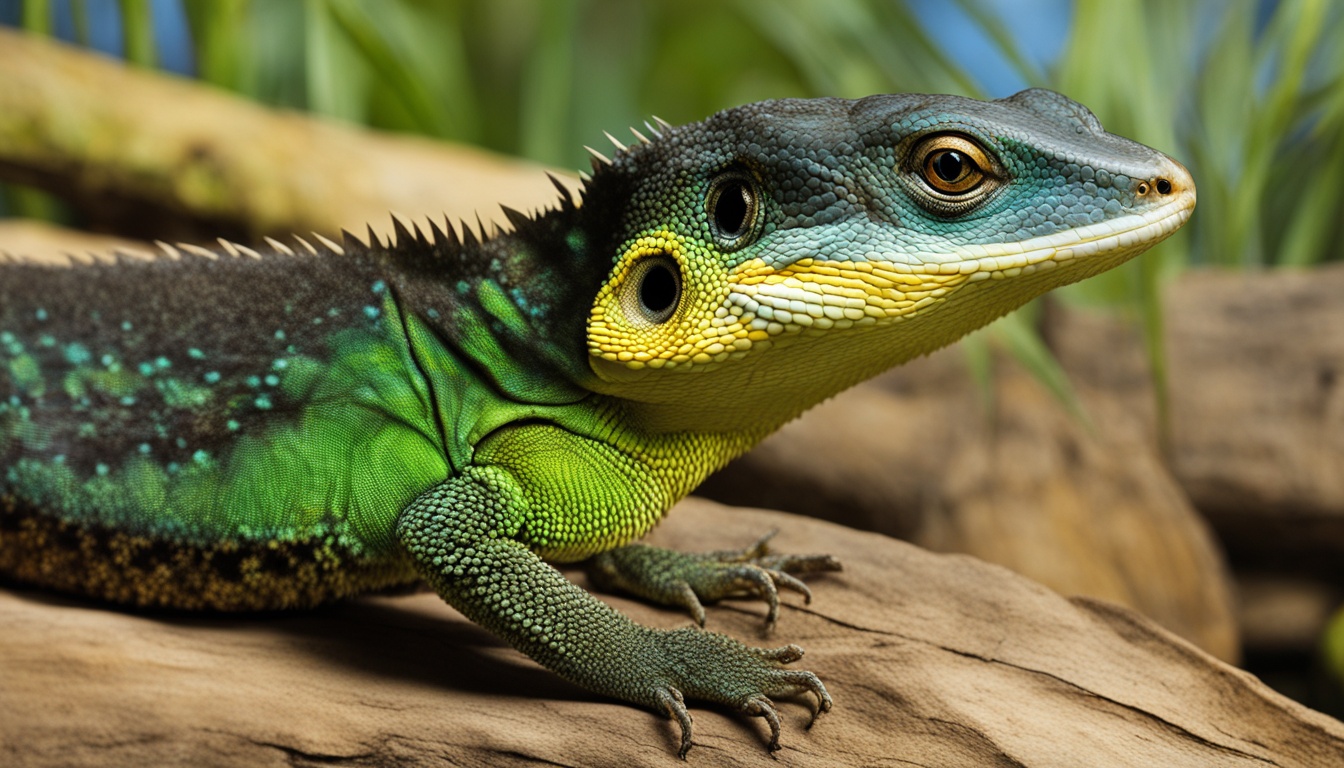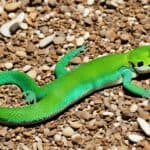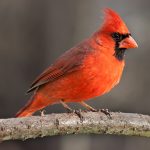To identify lizard species, look at their body, scale texture, and color. The USA has over 205 species of lizards, making it a fun learning activity.
Learning about where they live, the places they like, and how they act can also help. For example, tiny geckos and big, venomous Gila monsters can be told apart in this way. Knowing these details makes it easier to spot the types of lizards in America.
Overview of Common Lizard Families in the USA
The USA has many different lizard families, each with its own unique features. This guide will help you spot some of the most famous families across America.
Agamidae
Known as dragons, Agamidae lizards look very different from each other. You can recognize them by their sturdy bodies, prickly skin, and sometimes a big frill.
Anguids
Anguids, or glass lizards, have long bodies and can shut their eyes. These special traits set them apart from other lizards. They also have a hard outer layer and move in interesting ways. This offers a glimpse into how lizards adapt and change over time.
Chameleons
Chameleons, although new to the USA, are well-loved for their color change. They have special feet and tails that help them grip. Learning about these distinct features is vital for understanding American lizard families.
Knowing about each lizard type’s unique characteristics will make you better at spotting them. This is true whether you’re a lizard expert or just love nature. Using this information can change the way you see and study lizards all over the USA.
Physical Characteristics of Lizards for Identification
Identifying lizards in America involves looking at their body features. By understanding these features, you can identify different species better. This makes your observations more accurate and informative.
Body Shape and Size
A lizard’s body shape and size are key in telling them apart. In America, you’ll find lizards of various sizes. Some are as small as the Sphaerodactylus, no bigger than a dime. Others, like the Chuckwalla, can grow very large. Looking at a lizard’s body shape can tell you a lot. Some have long bodies and small limbs. Others are more stocky with big limbs.
Color and Patterns
Lizard colors and patterns are important for their identification. Many lizards have unique colors and patterns for hiding or attracting mates. You’ll see a lot of variety, from stripes to spots, on different lizards. These patterns differ from one lizard age or subspecies to the next. Knowing these details helps you identify them accurately.
Scale Texture
The feel of a lizard’s scales helps in their identification too. Their scales can be smooth, shiny, or have keels and spines. Lizards with smooth scales often live in damp places. The ones with keeled scales are more likely to live in rough terrains. These scales give us clues about a lizard’s life and how it has adapted over time.
Geographical Distribution of Lizard Species
Lizard species live in different climates and terrains across the USA. Knowing where each type lives helps identify them. This is because each species is adapted to its home’s unique conditions.
Western Regions
In the West, lizards thrive in hot, dry places like deserts. Species like the Desert Iguana and Western Banded Gecko do well here. These lizards have light-colored scales that help them survive. The scales reflect sunlight and keep moisture in.
Eastern Regions
In the East, lizards live in forests and humid areas. Lizard types include the Green Anole and Five-lined Skink. They have bright colors and patterns that help them hide in greenery. Understanding where lizards are from in the East lets you notice their special features.
Central Regions
In the Central USA, lizards adapt to different temperatures and lands. You’ll find lizards that live in open areas and places with rocks. The Prairie Lizard and Eastern Collared Lizard are examples. They show how lizards can live in many places.
Learning about where lizard species live in the USA helps you know and enjoy the many kinds of lizards here. It makes it easier to identify them too.
Behavioral Traits of American Lizards
Knowing about the behavioral traits of American lizards helps you tell species apart. Look at how they sunbathe, dig, and search for food. This tells us where they prefer to live and what they do each day. Most lizards are active during the day, but some like geckos come out at night.
American lizards show off their territories in different ways, like by showing off or making sounds. Male Anoles, for instance, show off their colorful throats to mark their space or impress mates. These actions are key to spotting different lizard types.
Some lizards even have special dances and color changes they use to attract mates. These rituals are not just for finding a partner; they also give us a glimpse into their group lives. Knowing about these behavioral traits of American lizards and what they physically look like helps us fully recognize them.
Here’s a chart showing typical behaviors for a few lizard types:
| Behavior | Species | Description |
|---|---|---|
| Basking | Western Fence Lizard | Often seen sunning on rocks during the day. |
| Burrowing | Desert Iguana | Creates burrows to escape heat and predators. |
| Foraging | Geckos | Mostly nocturnal, hunting insects at night. |
| Territorial Displays | Green Anole | Displays bright dewlap and performs head bobbing. |
Studying these actions can improve your ability to tell lizards apart. It also gives you insight into how these creatures live and interact. This makes distinguishing between species a more detailed task.
Distinguishing Native and Introduced Species
In the United States, telling native from introduced lizards is key for protecting the environment. Native lizards have grown in their lands for thousands of years. But, lizards that came because of human action are introduced. They can change the local ecosystem.
It’s important to know how each lizard got to where they are now. You look at their past, how they live now, and where they are. This way, you can help spot where lizards belong. This is crucial for keeping nature diverse and fighting invaders that can harm the local wildlife.
| Characteristic | Native Species | Introduced Species |
|---|---|---|
| Evolutionary Background | Evolved in the USA over millennia | Transported by human activities |
| Current Population Dynamics | Stable or naturally fluctuating | Often exhibit rapid growth and spread |
| Impact on Ecosystem | Integral to local food webs | Can be disruptive to native species |
| Conservation Concerns | Habitat loss, climate change | Control and management efforts |
Being able to tell if a lizard is native or introduced is vital for nature’s well-being. It’s critical for preventing harm and for protecting local lizards.
Identifying Lizards by Habitat Preferences
It’s key to know where lizards live to spot them. Lizards differ in how they fit into their homes – deserts, forests, or cities. This helps us figure out what type of lizard we’re seeing.
Desert Species
In deserts, you’ll find lizards with special skills for dry areas. Some have fringed toes. This helps them move quickly on sand. They’re usually light-colored to cope with the hot desert sun.
Forest and Woodland Species
Forest lizards like Skinks or Alligator Lizards are built for hiding. They match the woods with their colors. You might not see them because they’re good at staying hidden. Their smooth scales also help them slip through the trees.
Urban and Suburban Species
Cities are home to special lizards too, like the Mediterranean Gecko. They live on buildings and love city lights because they attract bugs. These lizards are smart and find ways to live amongst humans. You can recognize them by seeing where they hang out and how they look.
How do you identify different species of lizards in the USA?
To know how to identify different species of lizards in the USA, you need to look at a few key things. These include what the lizard looks like, where it usually lives, how it acts, and what places it likes. This mix of details helps you pinpoint the specific type of lizard.
Start by looking closely at their body. Size, shape, and markings can vary a lot. Also, their scales might have a special texture and they might have unique marks. These unique points are very important for telling them apart.
Think about where each type of lizard is found. Some prefer the dry West, while others like the East’s forests and swamps. Knowing this helps in spotting different lizard species.
Also, watch how these lizards act. Some are active during the day, while others prefer the night. The way they sunbathe or hide can also clue you in on their type.
Finally, consider their homes. Some lizards love deserts, while others live in green areas or even amongst people. Their favorite spots can help you figure out what kind they are.
| Aspect | Details |
|---|---|
| Physical Characteristics | Body shape, size, colors, patterns, and scale texture |
| Geographic Distribution | Western, Central, and Eastern regions |
| Behavioral Traits | Diurnal/nocturnal activities, basking, territorial displays |
| Habitat Preferences | Deserts, forests, woodlands, urban areas |
By combining all these elements, you can get really good at identifying lizards in the USA. Use books, the internet, and talk to experts for more help and to learn more.
Useful Tools and Resources for Lizard Identification
There are many lizard identification tools to help us. They are useful whether you’re new or an expert at spotting different lizard types. These tools improve our ability to tell lizard species apart.
Field Guides
Field guides are key resources for identifying lizard species. They have detailed pictures, information, and descriptions of various lizards. Books like the “Peterson Field Guide to Reptiles and Amphibians of Eastern and Central North America” and “A Field Guide to Western Reptiles and Amphibians” are top choices.
Online Databases
Online databases offer another approach to identifying lizards. Sites such as iNaturalist and the Reptile Database are very helpful. They contain a lot of photos, maps showing where species live, and information on their environment. This makes them great resources for identifying lizard species in the USA.
| Resource | Description | Best Used For |
|---|---|---|
| Field Guides | Detailed illustrations and species descriptions | On-site identification |
| Online Databases | Access to photographs, range maps, and ecological data | Comprehensive species research |
Examples of Common Lizard Species in the USA
The United States has many lizards that show its diverse environments. Each lizard has special features and lives in different areas. This creates a rich tapestry of lizard life across the country.
Western Fence Lizard
The Western Fence Lizard lives in California and is known as Sceloporus occidentalis. Males have bright blue patches. This lizard likes open forests and fields, where it suns on rocks and fences. It’s great at eating bugs, helping keep the insect population in check.
Green Anole
The Green Anole, or Anolis carolinensis, calls the Southeastern States home. It is green but can turn brown depending on its mood or the temperature. You can find Green Anoles in trees and shrubs, or even on buildings. Their ability to change color and their displays for mating are quite interesting.
Gila Monster
The Gila Monster, Heloderma suspectum, is very unique. Living in the southwestern deserts, this venomous lizard has black and orange skin. Despite its venom, it’s slow and only bites if threatened. Learning about Gila Monsters helps us understand and respect them.

| Species | Common Location | Unique Characteristics |
|---|---|---|
| Western Fence Lizard | California | Blue ventral patches, insect control |
| Green Anole | Southeastern States | Color-changing abilities, arboreal |
| Gila Monster | Southwestern Deserts | Venomous, bead-like scales |
Tips for Safely Observing and Handling Lizards
Being careful when watching and handling lizards is very important. This protects you and the lizards themselves. When in a lizard’s home area, try not to scare them. Watch them calmly from a distance, maybe through binoculars or with a good zoom camera. This is especially true when they might be more stressed, like during mating.
If you must pick one up, do it gently. Make sure to hold the lizard properly, supporting its whole body. Don’t squeeze it too hard and never grab its tail. This can hurt them or make them drop their tails, which is how some defend themselves. Know about the lizard you’re handling. For example, the Gila Monster is venomous, so be extremely careful.
Always think about your own safety first. Learn about the lizards in your area and any dangers they might pose. Knowing if something is risky can make your time with lizards safer and better. Also, always wash your hands after touching a lizard. This helps stop any diseases they might carry from spreading to you. These tips keep you and the lizards safe and show respect for nature.










